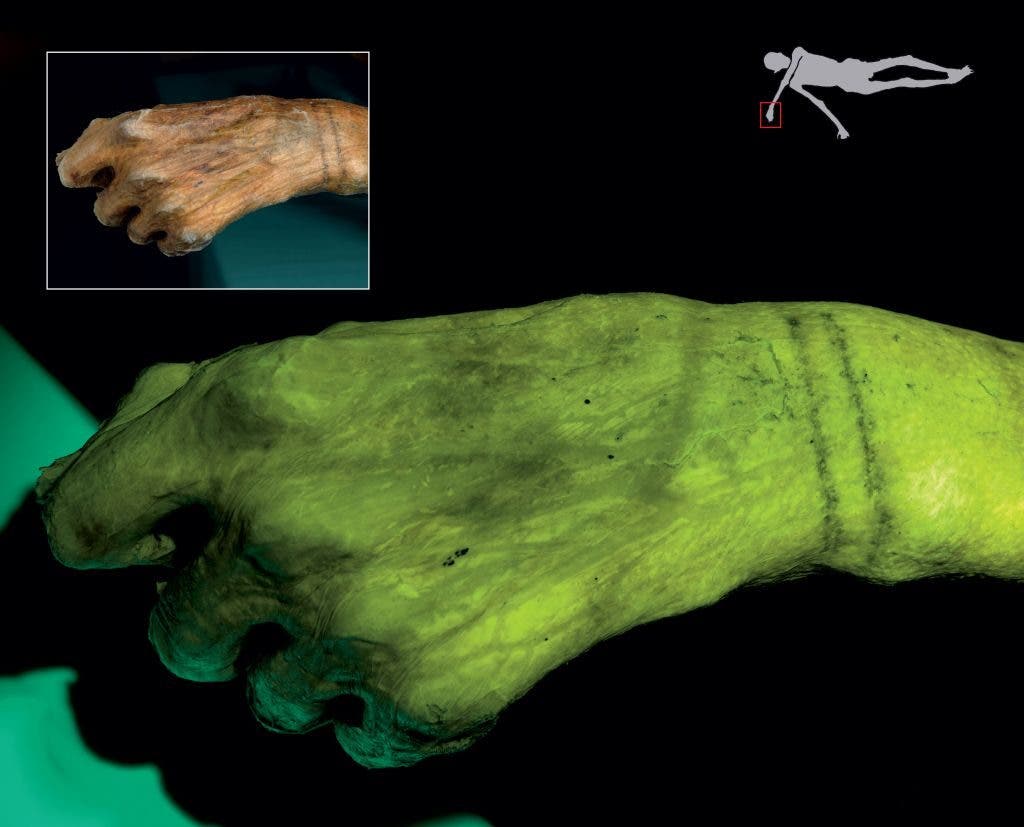
Hikers discovered Ötzi the Iceman in the Ötztal Alps of Tyrol, Austria in 1991. Forensic analysis showed that he died around 5,300 years ago, making his the oldest intact human body every found. Ötzi had been preserved by glacier ice and was found with his tools, clothes, and weapons – a time capsule of Copper Age life. While years of study have enhanced our knowledge of his world, recent work with the Iceman has shown that he still holds a few mysteries for science.
Ötzi’s ailments
The Iceman’s body was found with a rich set of tattoos, something that had never been seen from this period before. Early studies revealed about 50 markings, made by rubbing soot into small skin incisions. The body had been darkened by centuries in the snow, however, so the tattoos had little contrast. Finding them visually was difficult and researchers couldn’t be sure that they had discovered all of them.
Initially, scientists believed that this body art was for decoration, but further study yielded a more intriguing theory: Investigators noted that the tattoos were placed over areas of physical wear such as the wrist, knees, and ankles, which meant that their purpose might have been pain relief. A medical study later pointed out that the tattoo locations matched known acupuncture meridians. If this theory were correct, the practice would predate the earliest recorded use of acupuncture in China by 2,000 years.
Although the idea was exciting, the evidence wasn’t definitive, and some researchers had their doubts.Therefore, scientists recently took another at Ötzi, to create a complete map of his tattoos. This time, they came with technology.
Looking deeper . . .

Scientists from the South Tyrol Museum of Archaeology and the Institute for Mummies and the Iceman (at the European Academy of Bozen) recently surveyed Ötzi using multispectral photographic tools.
Multispectral imaging records the reflection responses of materials to different wavelengths of light and combines those results into a single, color-coded picture. Different reflectance properties make fine distinctions easier to see, exposing and highlighting fine contrasts. This imaging method has been used by art restorers to find evidence of earlier painting beneath a canvas, and archaeologists to recover writing on charred papyri.
The camera used for the Iceman survey was fitted with filters that captured wavelengths from ultraviolet (300 nanometers) to infrared (1,000 nanometers). Human visual response, for comparison, spans about 400 – 700 nanometers.
. . . yields new insights
After the survey, the tattoo count went up to 61, and the research team thinks that they’ve completed a full tally.
“It is an extraordinary result. Finally, we have been able to clarify many doubts on the existence of these tattoos,” said Marco Samadelli, of the South Tyrol Museum of Archaeology.

The survey produced a surprise, however, when it revealed a new group of tattoos on the right lower right side of Ötzi’s rib cage. Unlike the earlier tattoos, this group was in an area with no apparent physical ailment. So, did the markings represent medical treatments or not? Several possibilities still fit the pattern.
Ötzi might have suffered another condition that also resulted in chest pain, such as gallstones, colonic worms, or atherosclerosis (plaque in arteries). If this were the work of a Copper Age healer, then treating symptoms where they were reported would only be logical.
An unfinished story
Samadelli and his research team want to use the new mapping for fresh examinations into the purpose of the tattoos, including any relation to acupuncture points.
“Future comparative studies based on the known health problems of the Iceman as evidenced by radiological investigations and molecular studies, could help to find out whether the tattoos had a therapeutic, diagnostic or more symbolic background.”
The new imaging work has been published in the Journal of Cultural Heritage.
Analysis and interpretation of Ötzi’s tattoos will likely continue for a while, but at least the puzzle seems to have all its pieces now.
The Iceman has been teaching scientists about Copper Age life for almost 25 years, and new information is still coming to light.
Not bad for a chance discovery on a Tyrolean hike.


